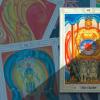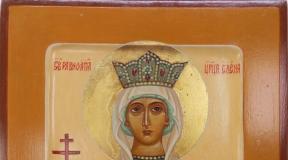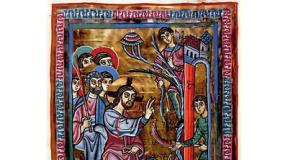The position of a person in the system. Common signs of humans and mammals. Evolution or outside interference
The place of man in the system of the organic world
A person is a social being, a distinctive feature of which is consciousness, formed on the basis of social and labor activity.
Man appeared on Earth as a result of a long process of development (anthropogenesis).
All living representatives of humanity belong to the same species - Homo sapiens which belongs to type of chordates,subtype of vertebrates, class of mammals, a detachment of primates and family of hominids .
Distinctive features of a person are:
- a very large (absolutely and relatively) brain with developed areas responsible for articulate speech and thinking;
- change in the proportions of the limbs - lengthening of the legs compared to the arms;
- S-shaped spinal column with pronounced cervical and lumbar bends;
- enlarged pelvis;
- chest flattened anteroposteriorly;
- arched foot with massive and adducted thumb and relative reduction (underdevelopment) of the rest;
- complete opposition of the thumb to the rest;
- reduction (underdevelopment) of the hairline;
- strong development of papillary patterns on the skin of the fingertips;
- an increase in the period of childhood.
Chordates Is a type of deuterostome animals.
 Chordates are characterized by the following features:
Chordates are characterized by the following features:
- axial skeleton in the form of a chord lying above the intestine, which in higher chordates (vertebrates) is replaced by the spine;
- the dorsal neural tube overlying the notochord (tubular central nervous system) from which the brain and spinal cord develop;
- paired metameric (segmental) gill slits in the pharyngeal wall, present throughout life (in primordial chordates) or at a certain stage of development (in terrestrial chordates).
 Mammals, or animals, is a class of animals belonging to the subtype of vertebrates of the chordate type. Man, being a representative of mammals, has all the main features characteristic of this class:
Mammals, or animals, is a class of animals belonging to the subtype of vertebrates of the chordate type. Man, being a representative of mammals, has all the main features characteristic of this class:
- mammary gland;
- hairline;
- skin glands(greasy and sweaty);
- four-chambered heart with left aortic arch;
- seven cervical vertebrae with modified first (atlas) and second (epistrophy) vertebrae;

- heterodontic(different in structure) teeth, among which incisors, canines and molars can be distinguished;
- three ossicles in the middle ear cavity and developed outer ear;
- lips, in the thickness of which the muscles are located;
- saliva containing enzymes;
- diaphragm separating the chest and abdominal cavities;
- lungs built from the alveoli;
- erythrocytes devoid of nuclei;
- larynx with vocal cords;
- eyelids with eyelashes.
Primates- This is a detachment of higher placental mammals. With most primates, humans have a number of common features:

The five-toed limb is the principle of the structure of the limbs of terrestrial vertebrates, including the general plan of the structure of the limbs of mammals and humans. In the process of evolution, individual details of the structure of the limbs may change, but the general principle remains unchanged.
- flat nails on the fingers and toes;
- the presence of papillary patterns on the palms and soles;
- poor development of the sense of smell, good - the organs of hearing and vision;

- DNA similarity(in humans and chimpanzees, about 90% of similar genes);
- the structure of facial muscles.
- low fertility, compensated by developed care for the offspring;
Great apes (hominoids, anthropoids)- this is superfamily of narrow-nosed monkeys , which includes the gibbon families (gibbons), pongid (orangutans, gorillas, chimpanzees) and hominids (representatives of the genus Man and the only living species of Homo sapiens).
 Anthropoid apes have a number of common features that allow us to attribute humans to this superfamily. These are the following signs:
Anthropoid apes have a number of common features that allow us to attribute humans to this superfamily. These are the following signs:
- large body size;
- lack of a long tail;
- similar shape of the auricle;
- large brain with developed grooves and convolutions;
- a similar structure of the teeth, especially the chewing surface ("driopithecus pattern");
- the structure of internal organs;
- the presence of an appendix;
- similar blood groups;
- similarity in the course of diseases, especially infectious.
Representatives of the pongid family, especially chimpanzees, have the greatest similarity with humans (the percentage of similar genes in humans and chimpanzees reaches 91).
Rudiments(lat. rudimentum- primordial principle), or vestigial organs, Are relatively simplified and underdeveloped structures that have lost their main significance in the process of historical development (phylogenesis).
 In humans, rudiments include:
In humans, rudiments include:
- tail vertebrae;
- appendix as a digestive organ;
- the muscles of the auricle;
- hairline of the trunk; The appendix is a rudiment only as part of the intestine that has lost its digestive function, although it plays an important role in the body - it is part of the immune system
- third eyelid.
Rudiments are laid during embryonic development, but do not fully develop. Unlike atavisms, rudiments are found in all individuals of the species.
 Atavisms(lat. atavus- ancestor) - signs that appear in individual organisms of a given species that existed in distant ancestors, but disappeared in the process of evolution.
Atavisms(lat. atavus- ancestor) - signs that appear in individual organisms of a given species that existed in distant ancestors, but disappeared in the process of evolution.
In humans, atavisms include:
- the presence of a tail;
- abundant hair on the body and face (hypertrichosis);
- multi-nipple;
- highly developed canines.
Man has a very ancient evolutionary lineage. Among the more and more ancient ancestors are: lower monkey, semi-monkey, lower placental mammal, primitive marsupial mammal, monotreous mammal, reptile, amphibian, lungfish, ganoid fish, primitive chordate animal of the lancelet type, common ancestor of the lancelet and invertebrate ... At the very beginning of the animal world, there are the first living creatures, which are, therefore, the starting point of development for man as well. The human egg is in some way reminiscent of this initial stage of phylogenetic evolution.
In terms of the structure and location of his organs, man belongs to the class of mammals. The most significant features inherent in both humans and mammals are the lactiferous, sebaceous and sweat glands, body hair, specialized teeth (incisors, canines, premolar and molars), the four-chambered heart and the left aortic arch, pulmonary respiration, the presence of a diaphragm, highly developed brain, intrauterine development of the embryo, feeding the baby with milk. Both in humans and in animals there are single links of tissue metabolism, growth and individual development are carried out in a similar way, the principle of storage and implementation of the genetic code, which is the same for the entire organic world, etc. chimpanzee, orangutan, gibbon.
It is almost impossible to distinguish between the embryos of humans, primates and other vertebrates in the early stages of development. In the human embryo, a notochord, gill furrows, branchial arches and a corresponding network of blood vessels are formed, similar to the way in the ancient shark fish. Some features of the "fish stage" of development can manifest themselves in humans in the form of atavisms. An example is cervical fistulas communicating with the pharynx. In the process of embryonic development in humans, a number of other similar signs appear and then disappear, but some of them persist in the form of rudiments, indicating a clear connection with the animal world. These include: the tailbone - the remainder of the tail, expressed in the spine of the embryo at the age of 1.5-3 months of intrauterine development, the outer scalp, the appendix of the cecum, the subcutaneous muscles, which are developed in humans only on the face and in the form of a rudiment there is a subcutaneous ear muscle, etc. In total, a person has more than 90 rudiments.
From reptiles, man has inherited a number of features that are found mainly in the uterine period, for example, in the development of the brain, the structure and nature of the articulation of the limbs in a fetus of several months.
The nature of the distribution of hair on the body of the fetus in groups of three and five pieces to a certain extent corresponds to the way the scales are located on the skin of ancient reptiles, which served as the ancestors of mammals. Among the later ancestors of man were ancient mammals, as evidenced by even more facts. Thus, the brain of a human fetus at the early stages of development, with its smooth surface and primitive structure, strongly resembles the brain of modern lower mammals (these features are inherited by humans, probably from their Mesozoic forms).
Other primitive traits that are found in his ontogeny also testify to the kinship of man with lower mammals. For example, in a six-week-old human embryo, the rudiments of several pairs of mammary glands are formed along the milky lines. Throughout the body (except for the palms and soles), a rather dense, albeit small, hairy down develops. In the oral cavity on the soft palate, noticeable ridges are formed, in a pronounced form so characteristic of monkeys, carnivores and other mammals.
This shape of the outer ear is characteristic of human fetuses at the age of 5-6 months and is inherited, obviously, from the fossil lower monkey, in some respects similar to the monkey and constituting one of the links in our pedigree. In the case of incomplete wrapping of the curl of the shell, a small skin growth in the form of a tubercle, called "Darwin's", is formed on its upper-lateral area.
The atavisms from the mammalian stage also include: an unusually strong development of the ear muscles, which allows a person to move the auricle; development of the morganic ventricles of the larynx to a depth of over 1 cm; extra breasts, or nipples; the rudiments of some extra teeth; excessive hairiness on the body and face; tail. Every person has a appendix of the cecum, or appendix: this vestigial organ is indisputable evidence that our ancestors at the stage of lower mammals had a rather long cecum. In some modern mammals, for example, rodents, ungulates, an energetic process of digestion of food masses occurs in the cecum.
The appendix is one of the many rudiments of the human body. An extremely characteristic feature of rudiments as residual organs is the strong variability of their shape, size and structure. So, with an average length of 8-9 cm, the appendix in humans sometimes reaches 20-25 cm, like in great apes; it can be very shortened, up to 1-2 cm, and in very rare cases it is completely absent. Being rich in lymphoid tissue, especially at a young age, the appendix seems to correspond to some part of the cecum of other mammals without appendix.
At one time, Charles Darwin gave convincing evidence of the phylogenetic community of emotions and the ways of expressing them, dedicating a separate work to them, closely related to The Descent of Man. In the essay "Expression of Emotions in Man and Animals", published in 1872, Darwin successfully showed that in terms of elementary mental activity and ways of expressing sensations, man is undoubtedly genetically related to apes. Another important finding is that there are no psychic differences among the races of man.
Charles Darwin in his time concluded that none of the modern apes is the direct ancestor of people. The genealogy of man is made up of a long chain of his predecessors, it goes back tens of millions of years, and the last link before the first people was the fossil apes. The fossil precursor of man, unknown during Darwin's lifetime, was subsequently discovered, confirming the scientist's scientific foresight.
Biology lesson. Grade 9.
Theme : “The place of man in the system of the organic world. Man as a species, his resemblance to animals and difference from them. "
Goals and objectives of the lesson:
1. To acquaint students with the main groups of evidence of the origin of humans from animals that modern biological science has.
2. To form the ability to compare humans with other mammals and draw conclusions based on this comparison.
3. Convince students that human origins could be related to the evolution of ancient apes.
Equipment :
1. Interactive tutorial "Evolutionary doctrine".
2. Models of human predecessors.
3. Handout material.
Lesson plan:
1. The origin of man, the history of the issue.
2. The systematic position of a person.
3. Evidence of the origin of humans from animals.
4. Human evolution.
5. Consolidation of knowledge on the topic.
During the classes .
What is the origin of man, how did he appear on Earth? There are many opinions on this matter. (Students express versions of human origin known to them). Accumulation of scientific evidence, especially in last years, when the genomes of humans and many other organisms were deciphered, made it possible to build and substantiate the theory of the origin of humans from animals. Today we will look at the evidence for the origin of humans from animals that underlies this theory.
In his system of animal life, K. Linnaeus placed humans in a group of primates, along with semi-monkeys and monkeys. J. B. Lamarck was the first to write that man descended from ape-like ancestors who went from climbing trees to walking on the ground. New way movement led to a straightening of the body, the release of the arms and a change in the foot. The herd lifestyle contributed to the development of speech.
In the Books "The Origin of Man and Sexual Selection", "On the Expression of Emotions in Man and Animals" Charles Darwin comes to the conclusion that man is an integral part of living nature and that his emergence is not an exception from the general laws of the development of the organic world. Having extended the main provisions of the evolutionary theory to humans, Charles Darwin introduced the problem of human origin into the mainstream of natural science research. First of all, he proved the origin of man "from the inferior animal form." In the book The Origin of Man (1871), Charles Darwin convincingly proved that man is the last highly organized link in the chain of development of living beings and has common distant ancestors with great apes. Earth for hundreds of millions of years. However, Charles Darwin did not stop there. On the basis of comparatively anatomical, embryological data indicating a great similarity between humans and great apes, he substantiated the idea of their relationship, and, consequently, their common origin from the ancient original ancestor. This is how the "monkey" theory of anthropogenesis was born.
According to the named theory, man and modern great apes descended from a common ancestor who lived in the Neogene era and is, according to Charles Darwin, a fossil ape-like creature. German scientist E. Haeckel called the missing transitional form Pithecanthropus. In 1891, the Dutch anthropologist E. Dubois discovered parts of the skeleton of a humanoid creature on the island of Java, which he called Pithecanthropus erectus. Over the past century, outstanding discoveries have been made, as a result of which numerous bone remains of fossil creatures have been discovered - intermediate between the ape ancestor and modern man. Thus, the validity of Charles Darwin's simial theory of anthropogenesis was confirmed by direct evidence.
The main groups of evidence of the origin of humans from animals:
1. Paleontological.
2. Embryological.
Coming out of the animal kingdom, Homo sapiens remains one of its members, although he is in a special position (entry in notebooks):
Kingdom | Animals |
Subkingdom | Multicellular |
Type of | Chordates |
Subtype | Vertebrates, or Cranial |
Class | Mammals |
Detachment | Primates |
Section | Narrow-nosed monkeys |
Family | Hominids |
Genus | Human |
View | Homo sapiens |
This is our position in the system of the organic world.
Man is a representative of the mammalian class, he is a vertebrate animal and therefore is related to fish, amphibians, reptiles and birds.
Working with handouts.
Work with interactive tutorial "Evolutionary doctrine".
The relationship between great apes and humans is evidenced by the similarity of many anatomical and physiological features. This was first established by Charles Darwin's colleague, T. Huxley. After conducting comparative anatomical studies, he proved that the anatomical differences between humans and higher apes are less significant than between higher and lower apes.
Let us recall the concepts of "rudiments" and "atavisms" (writing in notebooks).
Rudiments - these are organs that once actively functioned in our ancestors, and now have lost their meaning.
Atavisms - these are signs characteristic of animals and appeared in humans.
Human resemblance to animals(entry in notebooks).
(man descended from a common ancestor with great apes)
1. General plan of the structure of organ systems, sections of the skeleton;
2. The similarity of the embryos;
3. The presence of rudiments (coccyx, appendix, third eyelid);
4. The presence of atavisms (multi-nipple, hairiness, appearance of the tail);
5. Composition of blood;
6. Chromosome set in the cell (humans - 46, chimpanzees - 48)
7. Presence of nails on the fingers;
However, there are significant differences between humans and great apes, largely due to the adaptability of humans to upright posture.
The difference between humans and animals(entry in notebooks).
1. Vertical position of the body;
2. Ability to walk on two limbs;
3. The forelegs are adapted for grasping;
4. Large brain volume;
5. Double arch of the foot;
6. Ability to manufacture and use tools.
Homo sapiens' body is built of the same basic chemical elements as the body of any other living being, i.e. from carbon, hydrogen, oxygen, nitrogen and phosphorus. We differ from other mammals only in the structure and functioning of cells, tissues and organ systems.
The human body has four critical features, the combination of which is inherent only in him, is an erect skeleton, movable arms capable of manipulating objects, three-dimensional color vision and a brain that is unique in complexity.
An erect skeleton allows us, unlike other animals, to move on two legs. Without feeling the need to lean on our forelimbs, we use flexible and sensitive fingers to explore the surface of objects.
Forward-looking eyes provide binocular vision and allow us to accurately focus images, determine distance, distinguish not only color, but also shape. We can follow the movement of an object without turning our heads - with just the movement of our eyes.
Compared to other animals, the human brain is very large in relation to body size. Thanks to the brain, a person has excellent learning abilities, logical thinking, speech control; coordination of vision and hand movements.
View models of human predecessors.
Consolidation of knowledge on the topic... Performing test tasks in exercise books from the interactive study guide"Evolutionary doctrine". Checking answers with a teacher.
Frontal conversation.
1. What are the signs of a person that allow us to classify him as a subtype of vertebrates?
2. Indicate the signs that determine the position of man in the class of mammals.
3. What traits are common to humans and apes?
5. List the structural features inherent only to humans.
Conclusion.
Discussion.
Together with the whole class, the question is discussed: "Who has doubts about our origin from animals?"
Nature! Man is your creation
And this honor will not be taken away from you,
But I put it on my feet from all fours
And labor made the ancestor man.
S. Shchipachev
Homework... § 44, answer questions 1-3, p. 165 - 166. § 45, answer questions 1 - 3 p. 170 (question number 3 - in writing).
Scientists call anthropogenesis the period from the moment the first ancestral forms of man appeared in East Africa (about 1.7 million years ago) to the present, and they also try to determine the place of man in the result of this study, the creation of a whole group of scientific disciplines: anthropology, social psychology, socionists, who consider a person as an object of the animal world, taking into account that he is a completely unique being of spiritual nature. In this article, we will answer the question of what is the place of man in the system of the organic world, taking into account his duality, which consists in combining the traits of a physical and subtle nature.
Systematic position of Homo sapiens
All living beings living on our planet have a strictly defined position in the classification system of nature. Let's consider what is the place of man in the system of the organic world.
Empire is the dominant systematic category. It is called Life. This is followed by a taxon such as a domain (super-kingdom). Life includes two kingdoms: Prokaryotes and Eukaryotes. Man enters into the Eukaryote domain (Nuclear organisms). This is followed by the Kingdom of Animals, class Mammals, infraclass Placental, order of Primates, family of Hominids, genus People, species Homo sapiens. All living individuals included in the above taxonomic units form an aggregate called humanity.
How to prove the animal origin of a person
Studies carried out by taxonomists have confirmed that the place of man in the system of the organic world is the class Mammals, which also includes such taxa of animals as the families of Felines, Canids, Bats, Rodents, Artiodactyls, etc. Despite external differences in structure, all representatives of placental mammals, which include humans, have common anatomical and physiological features. These include a 4-chambered heart, two circles of blood circulation, warm-bloodedness. The general plan of the structure of the fore and hind limbs, as well as their girdles, in all animals of this taxon is similar to the anatomical structure of humans. For example, the upper limb in all mammals consists of the humerus, ulna, and radius, as well as the bones of the wrist, metacarpus and phalanges of the fingers.

Metabolic reactions in humans and placental mammals are quite similar. For example, the breakdown of organic compounds under the action of digestive enzymes, the transfer of oxygen by erythrocytes, the formation of uric acid as final product activity of the excretory system. The mechanisms of neuro-humoral regulation of vital activity are common. This confirms the fact that man in the system of the organic world is closely related to representatives of vertebrates belonging to the Mammals class.
Embryological evidence for the animal nature of man
It is not only the results of research in the field of anatomy and physiology that prove that we have a common origin with the animal world. Research in the field of embryology, which studies the embryonic development of vertebrates, from the superclass Pisces to the class Mammals, serves as a serious confirmation of this fact. The biogenetic law, formulated by F. Müller, combined the historical development of each species with the ontogeny of a single individual. All vertebrates, including humans, go through the stages of an egg, a single-layer embryo - blastula, and a two-layer embryo consisting of ectoderm and endoderm - gastrula.

On early stages development, without exception, all chordate embryos have gill slits, a tail and a similar body shape. This serves as proof that the place of man in the system of the organic world is next to animals. Moreover, many scientists are convinced that all terrestrial vertebrates descended from common ancestral forms.
Rudiments and atavisms
With the help of such a discipline as comparative anatomy, you will determine the place of a person in the system of the organic world, since a clear connection can be seen in the structure of the body and individual organs in mammals. For example, the appendix is a rudiment confirming that the common ancestors for us were herbivorous forms of animals. And although it has lost its importance in human digestion, it continues to play an important role in the breakdown of fiber in artiodactyls and other herbivorous animals. Such a rudiment as the third eyelid, which does not perform any function in the human organ of vision, plays an important role in vertebrates of the Reptile class, for example, in snakes.

The ear muscles are vestigial in humans, so the auricle is practically immobile. But in the predatory squad, this muscle group is especially well developed, which provides them with protection and orientation in the environment.
Atavisms: the appearance of a tail, many nipples, abundant development of hair on the face and other parts of the body - indicate the place of a person in the system of the organic world, taking into account his animal origin.
Anatomical features associated with upright posture
The phenomenon of the vertical position of the body has led to the appearance of certain features in the anatomical structure of the human body. For example, the S-shape of the spine, which increases flexibility and softens shocks and shocks when walking and running, the cupped shape of the pelvis, in which the internal organs, special structure of the foot - it has an arch that provides shock absorption and protection lower limbs when walking. All these features are inherent only in humans and are not found in any species of animals. This indicates a special modern place of man in the system of the organic world, separating him from other representatives of the Animal kingdom.
Social factors of human evolution
Walking upright played an important role in the formation of the human individual. The upper limb - the hand - was freed from the functions of movement and began to be used to perform subtle and complex operations: writing, labor actions, playing on musical instruments etc. The ability to produce and use fire both for protection and for cooking thermally processed food finally separated the representatives of the species Homo sapiens from other animals and marked the exclusive place of man in the system of the organic world.

Development of thinking and speech
The use of artificially created tools and life in primitive communities led to the formation of a qualitatively different signaling system which differs from the "language of animals". The complication of interneuronal contacts in the left hemisphere and the frontal lobe (Wernicke's and Broca's zones) provided the activation of the areas of understanding and motor skills of speech. The ability for complex mental operations: analysis, synthesis, abstraction - was the result of human evolution - anthropogenesis. He led to the formation modern man reasonable.
Anthropogenesis and the dual nature of man
Being a part of living nature and submitting to its evolutionary development, human society as a whole, like each of its individual individuals, is a reflection of its social relations, which have developed as a result of the historical, religious and cultural characteristics of various human populations. Such a scientific discipline as sociobiology, which is, in fact, a compilation of genetics, sociology, biology, psychology, tries to link the postulates into a single whole natural selection acting in living nature, with such purely human phenomena as altruism and culture. They are dominant in human behavioral reactions and determine its fundamental difference from the reflexes and instincts of animals.

Humanity and its social model
Objectively assessing the role of the biological component in human evolution, as well as taking into account close connection with wildlife, it must be remembered that all the above facts prove that the biological species of Homo sapiens throughout anthropogenesis was formed according to the laws of the development of human society, which are studied by sociology, social science, and psychology. The connection between man and the animal world is clearly traced by such a science as biology. The place of man in the system of the organic world is unique, since it is he who is a dual being.

All known spiritual and philosophical theories that arose in Ancient Babylon, Greece and the Roman Empire speak about this. They were transformed and formed as the ideas of the main religions of the world: Judaism, Christianity, Islam and Buddhism. The largest centers of world civilizations arose on the basis of socio-economic relations. Thanks to them, a special form of life on Earth, called humanity, appeared and formed.
Remember!
What are the common signs of representatives of the Chordate type; class Mammals.
The data of comparative embryology and anatomy of humans and other animals make it possible to clearly determine that, according to the criteria of zoological systematics, the species Homo sapiens (Homo sapiens) belongs to the Kingdom of Animals, the subkingdom of Multicellular, type Chordates, subtype Vertebrates, class Mammals, order of Primates, family of Hominids (Fig. 144).
Rice. 144. The systematic position of man in the order of primates
Let us consider those properties and signs on the basis of which we occupy this position in the system of the organic world.
Comparative Anatomy Data. It is unlikely that anyone will dispute our belonging to a certain kingdom and sub-kingdom. We are bilaterally symmetrical multicellular animals and in these characteristics are similar to all worms, arthropods and chordates.
For a person, as for all representatives type Chordates, common features of the organization are characteristic that are not found in other types.
The human embryo has an internal axial skeleton that is not segmented into segments - the chord. Our nervous and digestive systems are laid in the form of two tubes lying on opposite sides of the notochord. At the early embryonic stage of development, the anterior part of the human digestive system - the pharynx - is pierced with gill slits, which later disappear, and one of them gives rise to the auditory canal and the Eustachian tube. The human circulatory system is closed, and the heart is located on the abdominal side of the body.
The chordate type is divided into three subtypes, and the vertebrate subtype, in turn, unites six classes. We list the signs that make us related to other representatives class Mammals: bony spine replacing the notochord; seven cervical vertebrae; two pairs of lever-type limbs; the presence of bone marrow (bones are hollow in birds); hairline; sweat and sebaceous glands of the skin; mammary gland; well developed lips and muscular cheeks; diaphragm; three auditory ossicles of the middle ear (in birds and reptiles - one); Auricle; four-chambered heart, two circles of blood circulation and one left aortic arch; non-nuclear erythrocytes (in all other classes of vertebrates - nuclear); alveolar lungs. In addition to these morphological features it should be noted that all mammals, including humans, are characterized by such progressive features of the organization as the high development of the central nervous system, especially the cerebral cortex; diverse adaptive reactions and complex behavior; intensive metabolism and perfect thermoregulation. Intrauterine development and nutrition of the embryo through the placenta characterizes us as representatives subclass Placental. It should be noted that all the listed morphological characters common to humans and other mammals are homologous, that is, they have the same origin.
Common features of a person and other representatives detachment Primates are the following: a limb of the grasping type (the first finger of the hand is opposed to the rest); the presence of a clavicle, which ensures high mobility of the hand; dilated terminal phalanges of the fingers with nails; teeth of three types - incisors, canines, molars; high development of the cerebral hemispheres; reproduction throughout the year; the presence of one pair of mammary glands; the birth of usually one cub and long-term care for him; complex organization of relations between individuals and a high level of development of higher nervous activity.
The kinship of man with animals is also evidenced by numerous rudiments and atavisms, which are known for almost all organ systems. Rudiments are underdeveloped organs that have practically lost their functions in the process of evolution. Their presence indicates a relationship between humans and lower-organized vertebrates. Examples of such rudiments are the muscles of the auricle, tail vertebrae (coccyx), remnants of the blinking membrane of the eye, and the appendix of the cecum. Atavisms are traits that once existed in our ancestors, were later lost, but the genes responsible for their development are still preserved and, under certain conditions, cause the formation of these ancient traits. Striking examples of atavisms are the hair on the face, the outer tail, extra pairs of mammary glands, membranes between the fingers (Fig. 145).

Rice. 145. Atavisms of Man
Comparative embryology data. In addition to the data of comparative anatomy, the results of a comparative study of the ontogenesis of humans and animals are significant evidence of the origin of humans from animals.
The individual development of man, like other sexually reproducing animals, begins with the formation of a zygote. At two weeks of age, the human embryo shows signs of fish-like ancestors: a two-chambered heart, gill slits, and a caudal artery. Later, in the structure of the embryo, you can observe features inherited from amphibians: the blinking membrane in the inner corner of the eye, swimming membranes between the fingers. A six-week-old embryo has several pairs of mammary glands, the tail section of the spine is laid, which is then reduced and turns into the coccyx. The smooth surface of the cerebral hemispheres and the solid hair coat in the human fetus indicate a relationship with primitive mammals. Thus, the main features of human embryonic development clearly determine its animal origin.

Rice. 146. Great apes
Similarities and differences between humans and great apes. With great apes, people have many features in common, such as a large body size, the absence of a tail and cheek pouches, good development of facial muscles and a similar structure of the skull (Fig. 146). Chimpanzees, gorillas, orangutans have a well-developed brain, especially its frontal lobes, big number convolutions in the cerebral cortex. In addition to morphological signs, other data also testify to our close relationship: we are similar in Rh factor and blood groups (AB0), we suffer from the same "human" diseases. Pregnancy for both gorillas and humans is about 280 days.
The evolutionary relationship of organisms can be determined by comparing their chromosomes. The greater the similarity between DNA nucleotide sequences, the closer the relationship between species. Humans and chimpanzees share over 95% of the genes that are similar.
Great apes, like humans, have a high level of development of higher nervous activity, they are easy to learn, they have an excellent memory and a rich emotional life.
At the same time, there are fundamental differences between humans and great apes. Only a person is characterized by a true upright posture (Fig. 147). Thanks to this, a person has long and powerful legs, an arched foot, a wide pelvis, an S-shaped spine. Flexible wrist and movable fingers provide precise and varied movement.

Rice. 147. Skeletons of monkeys and humans
A person has a very complex brain, the average volume of which is 1350 cm 3 (for a gorilla, 400 cm 3). Thanks to the development of the structures of the larynx, a person is capable of articulate speech.
Man is a biosocial being, occupying a high level of evolutionary development, possessing consciousness, speech, abstract thinking and capable of social work.
Review questions and assignments
1. Describe the systematic position of man in the animal kingdom.
2. Indicate the characteristics of a person as a representative of the mammalian class.
3. What traits are common to humans and apes?
4. List the structural features inherent only to humans.
5. What was the significance of the increase in brain volume in anthropogenesis?
| <<< Назад
|
Forward >>> |



















